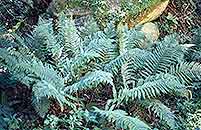Polystichum transvaalense N.C. Anthony
Synonyms |
Polystichum setiferum var. fuscopaleaceum sensu Schelpe |
|---|---|
Common name |
|
Description |
Rhizome short creeping or erect, up to 8 mm in diameter; rhizome scales up to 14 x 1 mm, margin irregularly lacerate, reddish-brown, linear, tapering to a point. Fronds tufted, erect to arching, 5-17 per plant, herbaceous. Stipe 20-54 cm long, pale brown to reddish brown at base, with a longitudinal groove above, densely set in the lower half with a mixture of fine, hair-like scales and large, ovate, reddish-brown scales, scales 6.5-20 x 1.4-6 mm. Lamina up to 65 × 30 cm, narrowly ovate in outline, attenuate, 2-pinnate, with basal pair of pinnae not or only slightly reduced. Pinnae up to 26 free pairs, to 14 x 2.8 cm. Pinnules elliptic to obovate in outline, basal acroscopic lobe well developed; margins aristate with aristae ± 0.5 mm long, basal basiscopic aristae folded in over the upper surface of the lamina; upper surface subglabrous, lower surface sparsely set with hair-like scales. Rhachis and secondary rhachis with matted, reddish-brown twisted hair-like scales up to 4.5 mm long. Sori round, in 2 rows halfway between the margin and the costules, c. 1 mm in diameter; indusia c.0.5-1 mm in diameter, peltate, erose, persistent. |
Notes | |
Derivation | transvaalense: from the Transvaal, South Africa where the type specimen was collected. |
Habitat | Moist forest, sometimes dry evergreen forest or bamboo, often near water. |
Distribution worldwide | See African distribution. |
Distribution in Africa |
Cameroon, Dem. Republic of Congo, Equatorial Guinea (incl. Bioko), Eritrea, Ethiopia, Kenya, Lesotho, Malawi, Mozambique, Rwanda, South Africa, Sudan and South Sudan, Tanzania , Uganda, Zambia, Zimbabwe. |
Growth form |
Epiphytic, terrestrial. |
Literature |
|
